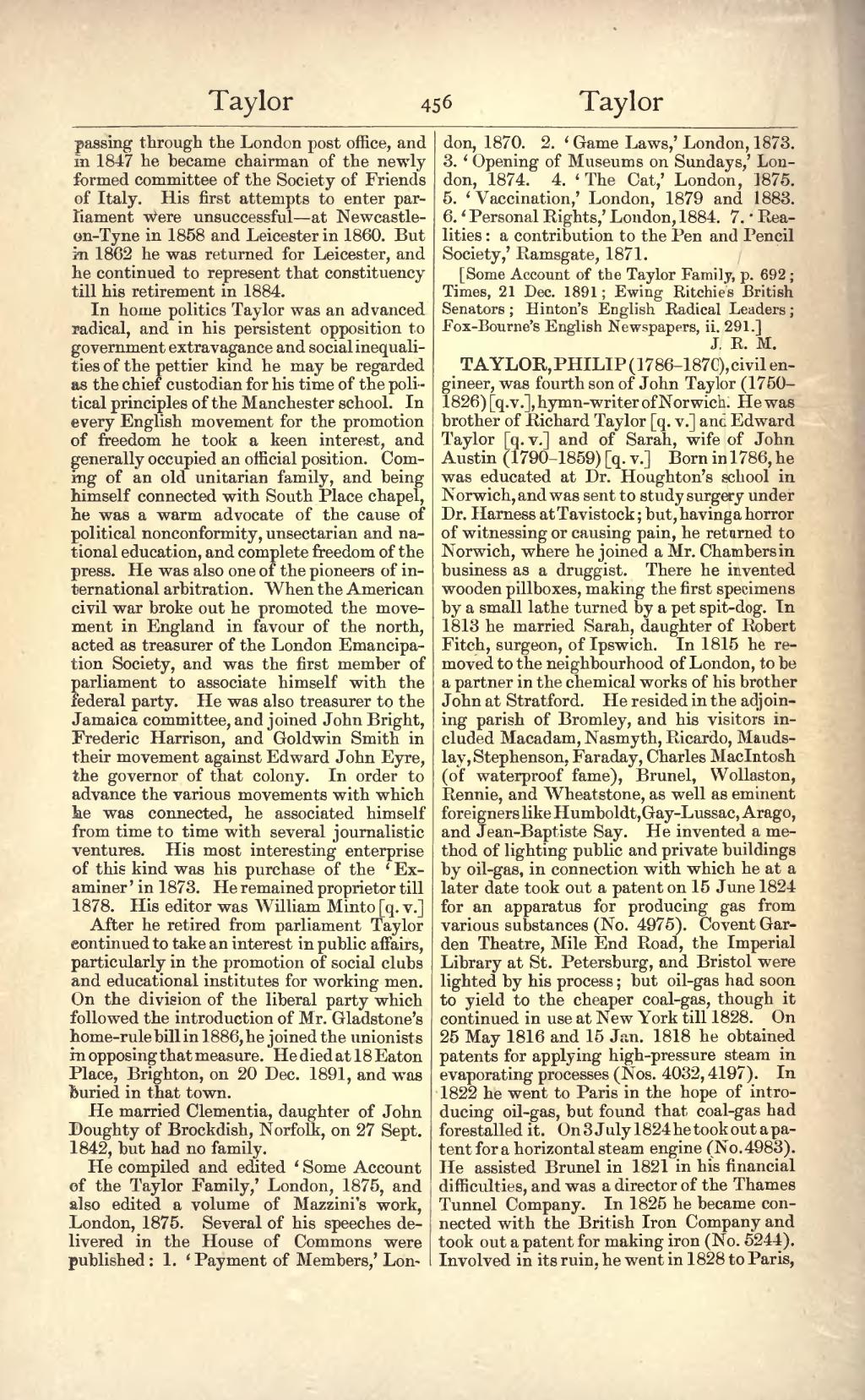passing through the London post office, and in 1847 he became chairman of the newly formed committee of the Society of Friends of Italy. His first attempts to enter parliament were unsuccessful—at Newcastle-on-Tyne in 1858 and Leicester in 1860. But in 1862 he was returned for Leicester, and he continued to represent that constituency till his retirement in 1884.
In home politics Taylor was an advanced radical, and in his persistent opposition to government extravagance and social inequalities of the pettier kind he may be regarded as the chief custodian for his time of the political principles of the Manchester school. In every English movement for the promotion of freedom he took a keen interest, and generally occupied an official position. Coming of an old unitarian family, and being himself connected with South Place chapel, he was a warm advocate of the cause of political nonconformity, unsectarian and national education, and complete freedom of the press. He was also one of the pioneers of international arbitration. When the American civil war broke out he promoted the movement in England in favour of the north, acted as treasurer of the London Emancipation Society, and was the first member of parliament to associate himself with the federal party. He was also treasurer to the Jamaica committee, and joined John Bright, Frederic Harrison, and Goldwin Smith in their movement against Edward John Eyre, the governor of that colony. In order to advance the various movements with which he was connected, he associated himself from time to time with several journalistic ventures. His most interesting enterprise of this kind was his purchase of the ‘Examiner’ in 1873. He remained proprietor till 1878. His editor was William Minto [q. v.]
After he retired from parliament Taylor continued to take an interest in public affairs, particularly in the promotion of social clubs and educational institutes for working men. On the division of the liberal party which followed the introduction of Mr. Gladstone's home-rule bill in 1886, he joined the unionists in opposing that measure. He died at 18 Eaton Place, Brighton, on 20 Dec. 1891, and was buried in that town.
He married Clementia (d. 11 April 1908), daughter of John Doughty of Brockdish, Norfolk, on 27 Sept. 1842, but had no family. He compiled and edited ‘Some Account of the Taylor Family,’ London, 1875, and also edited a volume of Mazzini's work, London, 1875. Several of his speeches delivered in the House of Commons were published:
- ‘Payment of Members,’ London, 1870.
- ‘Game Laws,’ London, 1873.
- ‘Opening of Museums on Sundays,’ London, 1874.
- ‘The Cat,’ London, 1875.
- ‘Vaccination,’ London, 1879 and 1883.
- ‘Personal Rights,’ London, 1884.
- ‘Realities: a contribution to the Pen and Pencil Society,’ Ramsgate, 1871.
[Some Account of the Taylor Family, p. 692; Times, 21 Dec. 1891; Ewing Ritchie's British Senators; Hinton's English Radical Leaders; Fox-Bourne's English Newspapers, ii. 291.]
TAYLOR, PHILIP (1786–1870), civil engineer, was fourth son of John Taylor (1750–1826) [q. v.], hymn-writer of Norwich. He was brother of Richard Taylor [q. v.] and Edward Taylor [q. v.] and of Sarah, wife of John Austin (1790–1859) [q. v.] Born in 1786, he was educated at Dr. Houghton's school in Norwich, and was sent to study surgery under Dr. Harness at Tavistock; but, having a horror of witnessing or causing pain, he returned to Norwich, where he joined a Mr. Chambers in business as a druggist. There he invented wooden pillboxes, making the first specimens by a small lathe turned by a pet spit-dog. In 1813 he married Sarah, daughter of Robert Fitch, surgeon, of Ipswich. In 1815 he removed to the neighbourhood of London, to be a partner in the chemical works of his brother John at Stratford. He resided in the adjoining parish of Bromley, and his visitors included Macadam, Nasmyth, Ricardo, Maudslay, Stephenson, Faraday, Charles MacIntosh (of waterproof fame), Brunel, Wollaston, Rennie, and Wheatstone, as well as eminent foreigners like Humboldt, Gay-Lussac, Arago, and Jean-Baptiste Say. He invented a method of lighting public and private buildings by oil-gas, in connection with which he at a later date took out a patent on 15 June 1824 for an apparatus for producing gas from various substances (No. 4975). Covent Garden Theatre, Mile End Road, the Imperial Library at St. Petersburg, and Bristol were lighted by his process; but oil-gas had soon to yield to the cheaper coal-gas, though it continued in use at New York till 1828. On 25 May 1816 and 15 Jan. 1818 he obtained patents for applying high-pressure steam in evaporating processes (Nos. 4032, 4197). In 1822 he went to Paris in the hope of introducing oil-gas, but found that coal-gas had forestalled it. On 3 July 1824 he took out a patent for a horizontal steam engine (No. 4983). He assisted Brunel in 1821 in his financial difficulties, and was a director of the Thames Tunnel Company. In 1825 he became connected with the British Iron Company and took out a patent for making iron (No. 5244). Involved in its ruin, he went in 1828 to Paris,
